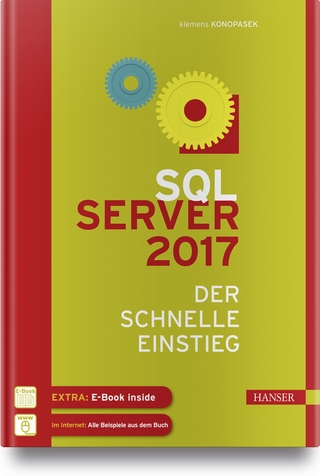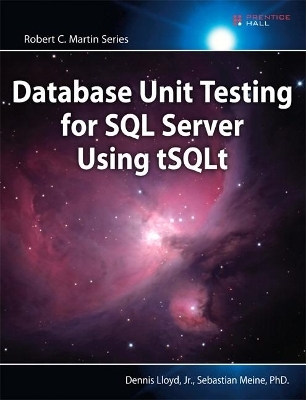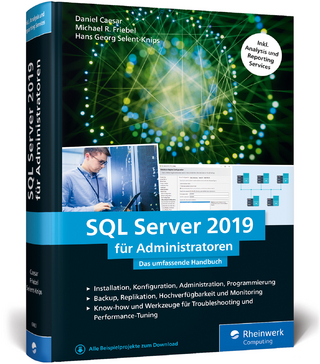
Language of SQL, The
Addison Wesley (Verlag)
978-0-13-465825-4 (ISBN)
The Language of SQL, Second Edition
Many SQL texts attempt to serve as an encyclopedic reference on SQL syntax -- an approach that is often counterproductive, because that information is readily available in online references published by the major database vendors.
For SQL beginners, it’s more important for a book to focus on general concepts and to offer clear explanations and examples of what various SQL statements can accomplish. This is that book.
A number of features make The Language of SQL unique among introductory SQL books.
First, you will not be required to download software or sit with a computer as you read the text. The intent of this book is to provide examples of SQL usage that can be understood simply by reading.
Second, topics are organized in an intuitive and logical sequence. SQL keywords are introduced one at a time, allowing you to grow your understanding as you encounter new terms and concepts.
Finally, this book covers the syntax of three widely used databases: Microsoft SQL Server, MySQL, and Oracle. Special “Database Differences” sidebars clearly show you any differences in syntax among these three databases, and instructions are included on how to obtain and install free versions of the databases.
This is the only book you need to gain a quick working knowledge of SQL and relational databases.
Learn How To...
Use SQL to retrieve data from relational databases
Apply functions and calculations to data
Group and summarize data in a variety of useful ways
Use complex logic to retrieve only the data you need
Update data and create new tables
Design relational databases so that data retrieval is easy and intuitive
Use spreadsheets to transform your data into meaningful displays
Retrieve data from multiple tables via joins, subqueries, views, and set logic
Create, modify, and execute stored procedures
Install Microsoft SQL Server, MySQL, or Oracle
Contents at a Glance
1 Relational Databases and SQL 2 Basic Data Retrieval 3 Calculated Fields and Aliases 4 Using Functions 5 Sorting Data 6 Selection Criteria 7 Boolean Logic 8 Conditional Logic 9 Summarizing Data 10 Subtotals and Crosstabs 11 Inner Joins 12 Outer Joins 13 Self Joins and Views 14 Subqueries 15 Set Logic 16 Stored Procedures and Parameters 17 Modifying Data 18 Maintaining Tables 19 Principles of Database Design 20 Strategies for Displaying Data
A Getting Started with Microsoft SQL Server B Getting Started with MySQL C Getting Started with Oracle
LARRY ROCKOFF has been involved with SQL and business intelligence development for many years. His primary area of interest is using reporting tools to explore and analyze data in complex databases. He holds an MBA from the University of Chicago, with a specialization in Management Science. He currently works with data warehouse and reporting applications for a major retail pharmacy. He also maintains a website that features book reviews on technology topics, focusing on analytics and business intelligence as well as broader societal issues at larryrockoff.com
The Language of SQL, 2nd Edition
Introduction Topics and Features What’s New in the Second Edition Plan of the Book Companion Website
1. Relational Databases and SQL What Is SQL? Microsoft SQL Server, MySQL, and Oracle Relational Databases Primary and Foreign Keys Datatypes NULL Values The Significance of SQL
2. Basic Data Retrieval A Simple SELECT Syntax Notes Comments Specifying Columns Column Names with Embedded Spaces Preview of the Full SELECT
3. Calculated Fields and Aliases Literal Values Arithmetic Calculations Concatenating Fields Column Aliases Table Aliases
4. Using Functions What Is a Function? Character Functions Composite Functions Date/Time Functions Numeric Functions Conversion Functions
5. Sorting Data Sorting in Ascending Order Sorting in Descending Order Sorting by Multiple Columns Sorting by a Calculated Field Sort Sequences
6. Selection Criteria Applying Selection Criteria WHERE Clause Operators Limiting Rows Limiting Rows with a Sort Pattern Matching Wildcards
7. Boolean Logic Complex Logical Conditions The AND Operator The OR Operator Using Parentheses Multiple Sets of Parentheses The NOT Operator The BETWEEN Operator The IN Operator Boolean Logic and NULL Values
8. Conditional Logic The CASE Expression The Simple CASE Format The Searched CASE Format Conditional Logic in ORDER BY Clauses Conditional Logic in WHERE Clauses
9. Summarizing Data Eliminating Duplicates Aggregate Functions The COUNT Function Grouping Data Multiple Columns and Sorting Selection Criteria on Aggregates Conditional Logic in GROUP BY Clauses Conditional Logic in HAVING Clauses Ranking Functions Partitions
10. Subtotals and Crosstabs Adding Subtotals with ROLLUP Adding Subtotals with CUBE Creating Crosstab Layouts
11. Inner Joins Joining Two Tables The Inner Join Table Order in Inner Joins An Alternate Specification of Inner Joins Table Aliases Revisited
12. Outer Joins The Outer Join Left Joins Testing for NULL Values Right Joins Table Order in Outer Joins Full Joins Cross Joins
13. Self Joins and Views Self Joins Creating Views Referencing Views Benefits of Views Modifying and Deleting Views
14. Subqueries Types of Subqueries Using a Subquery as a Data Source Using a Subquery in Selection Criteria Correlated Subqueries The EXISTS Operator Using a Subquery as a Calculated Column Common Table Expressions
15. Set Logic Using the UNION Operator Distinct and Non-Distinct Unions Intersecting Queries
16. Stored Procedures and Parameters Creating Stored Procedures Parameters in Stored Procedures Executing Stored Procedures Modifying and Deleting Stored Procedures Functions Revisited
17. Modifying Data Modification Strategies Inserting Data Deleting Data Updating Data Correlated Subquery Updates
18. Maintaining Tables Data Definition Language Table Attributes Table Columns Primary Keys and Indexes Foreign Keys Creating Tables Creating Indexes
19. Principles of Database Design Goals of Normalization How to Normalize Data The Art of Database Design Alternatives to Normalization
20. Strategies for Displaying Data Crosstab Layouts Revisited Excel and External Data Excel Pivot Tables
A. Getting Started with Microsoft SQL Server Installing SQL Server 2016 Express Installing SQL Server 2016 Management Studio Express Using SQL Server 2016 Management Studio Express
B. Getting Started with MySQL Installing MySQL on Windows Installing MySQL on Mac Using MySQL Workbench
C. Getting Started with Oracle Installing Oracle Database Express Edition Using Oracle Database Express Edition
| Erscheinungsdatum | 05.10.2016 |
|---|---|
| Reihe/Serie | Learning |
| Verlagsort | Boston |
| Sprache | englisch |
| Maße | 178 x 232 mm |
| Gewicht | 400 g |
| Themenwelt | Informatik ► Datenbanken ► SQL Server |
| Mathematik / Informatik ► Informatik ► Programmiersprachen / -werkzeuge | |
| Mathematik / Informatik ► Informatik ► Software Entwicklung | |
| Studium ► 1. Studienabschnitt (Vorklinik) ► Histologie / Embryologie | |
| ISBN-10 | 0-13-465825-6 / 0134658256 |
| ISBN-13 | 978-0-13-465825-4 / 9780134658254 |
| Zustand | Neuware |
| Haben Sie eine Frage zum Produkt? |
aus dem Bereich


